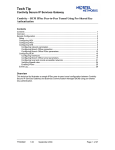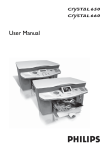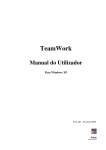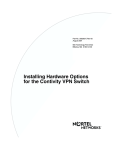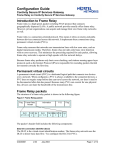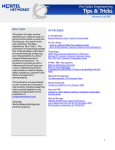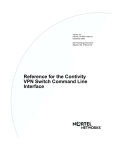Download Avaya Configuring Branch Office Tunnel between a Contivity and a BayRS Router User's Manual
Transcript
Tech Tip Contivity Secure IP Services Gateway Configuring Branch Office Tunnel between a Contivity and a BayRS router Contents Contents .......................................................................................................................................... 1 Overview.......................................................................................................................................... 1 Sample Configuration ...................................................................................................................... 1 Setup ........................................................................................................................................... 1 Configuring ARN ......................................................................................................................... 2 Configuring CES........................................................................................................................ 11 Branch Office Group IPSec Settings .................................................................................... 11 Branch Office Connection Configuration .............................................................................. 12 Reviewing the BayRS Router event log .................................................................................... 14 Reviewing the Contivity event log ............................................................................................. 15 Router Troubleshooting Tips..................................................................................................... 17 Router Scripts ....................................................................................................................... 17 Interpreting Log Messages on the Router ............................................................................ 18 Contivity troubleshooting tips .................................................................................................... 21 Interpreting Log Messages on the Contivity ......................................................................... 21 Appendix A – Setting the NPK on the BayRS router..................................................................... 23 Appendix B – Adding the capi.exe file to the router image ........................................................... 25 Overview This technical tip illustrates a sample branch office tunnel configuration between Contivity Secure IP Services Gateway and BayRS router. Sample Configuration Setup In this sample configuration, a Contivity 1010 running V04_85.160 code and an ARN running 15.5.0.0 code were used in the following configuration: 3.1.1.2 10.1.1.2 2.1.1.2 10.1.1.1 10.1.1.0/24 CES ARN 2.1.1.0/24 3.1.1.0/24 3.1.1.1 2.1.1.1 CES – code version V04_85.160, Private IP 3.1.1.2, Mgmt IP 3.1.1.254, Public IP 10.1.1.2 ARN – code version V15.5.0.0, Private IP 2.1.1.2, Public IP 10.1.1.1 TT040916 1.00 September 2004 Page: 1 of 29 Tech Tip Contivity Secure IP Services Gateway Configuring Branch Office Tunnel between a Contivity and a BayRS router Configuring ARN 1. First, both IPSec and IKE must be loaded on the public side Ethernet interface of the ARN. Click on corresponding Ethernet connector: 2. Click on Edit Circuit in the window that pops up: TT040916 1.00 September 2004 Page: 2 of 29 Tech Tip Contivity Secure IP Services Gateway Configuring Branch Office Tunnel between a Contivity and a BayRS router 3. In the Protocols drop down menu, select Add/Delete. Check the boxes next to IPSEC and IKE on the Select Protocols window that appears and then click OK: TT040916 1.00 September 2004 Page: 3 of 29 Tech Tip Contivity Secure IP Services Gateway Configuring Branch Office Tunnel between a Contivity and a BayRS router 4. Click Done to exit out of the next screen that appears. Next, from the drop down menus go to Protocols | Edit IP | IKE. Enter the Node Protection Key (NPK) configured on the router and click OK. Note: The NPK is configured from the secure shell in the console. 5. The Edit IKE SA Destination screen will appear. Click Add: TT040916 1.00 September 2004 Page: 4 of 29 Tech Tip Contivity Secure IP Services Gateway Configuring Branch Office Tunnel between a Contivity and a BayRS router 6. This process will define the endpoint address and pre-shared key for the Branch Office Tunnel. Configure a Name (For example, To CES), the Destination IP address of the endpoint of the tunnel (CES public IP address), and either an Ascii or Hex Pre-shared Key. This Pre-shared Key must match the key configured on the CES. When finished, click Done: 7. Click Done on the Edit IKE SA Destination screen. TT040916 1.00 September 2004 Page: 5 of 29 Tech Tip Contivity Secure IP Services Gateway Configuring Branch Office Tunnel between a Contivity and a BayRS router 8. From the drop down menu go to Protocols | Edit IP | IP Security | Outbound Policies. First we need to make a template to define the IPSec policy, so click on the Template button, and then Create on the IPSec Policy Template Management screen: TT040916 1.00 September 2004 Page: 6 of 29 Tech Tip Contivity Secure IP Services Gateway Configuring Branch Office Tunnel between a Contivity and a BayRS router 9. Using the drop-down menus, create a policy containing Action->Protect, and Criteria>Source & Destination IP address ranges corresponding to the Local (ARN local network, 2.1.1.0/24 in this case) and Remote (CES local network, 3.1.1.0/24 in this case) networks respectively. This is an example of what the template should look like when done: ** NOTE ** It is important to include the network and broadcast addresses in the range, i.e. x.x.x.0 and x.x.x.255 for a 24 bit subnet. 10. Click Done, and then Done again on the previous screen to return to the IPSec Outbound Policies screen. TT040916 1.00 September 2004 Page: 7 of 29 Tech Tip Contivity Secure IP Services Gateway Configuring Branch Office Tunnel between a Contivity and a BayRS router 11. Click Add Policy. Supply the policy a name, making sure the correct interface and the template just created are highlighted, and then click OK: 12. On the next screen click Automated SA, which indicates the tunnel will use IKE for the key exchange. Click the button next to SA Destination and select the entry for the CES. This endpoint was defined in the IKE configuration process: TT040916 1.00 September 2004 Page: 8 of 29 Tech Tip Contivity Secure IP Services Gateway Configuring Branch Office Tunnel between a Contivity and a BayRS router 13. Click the New Proposal button to set up a proposal list defining the encryption/integrity capabilities of the CES. The CES and the ARN need to have at least one option in common in order to establish a tunnel. For simplicity, only 3DES/MD5 is selected in this example, however, as many selections can be checked as needed. Click Done when finished: 14. Click the button labeled None next to Priority 1, select the proposal just created and click OK: TT040916 1.00 September 2004 Page: 9 of 29 Tech Tip Contivity Secure IP Services Gateway Configuring Branch Office Tunnel between a Contivity and a BayRS router 15. The configuration for the Branch Office Tunnel is complete at this point. Simply click OK and Done until you are back on the front screen. The last step is to configure a static route directing traffic for the Remote network (3.1.1.0/24 in this case) out the public interface. Using the drop down menus, go to Protocols | IP | Static Routes and click Add. Enter the Destination IP Address (remote network), Address Mask, and Next Hop Address so that this traffic will be directed out the public interface. An entry will need to be added for each remote network, or at least enough entries to cover every remote network: TT040916 1.00 September 2004 Page: 10 of 29 Tech Tip Contivity Secure IP Services Gateway Configuring Branch Office Tunnel between a Contivity and a BayRS router Configuring CES Branch Office Group IPSec Settings Configure appropriate branch office group setting. Navigate ProfilesÆBranch Office, select appropriate Group and click Configure next to it, scroll down to the IPSec section and click Configure under it. Encryption: A compatible setting must be selected on both the CES and Router. In this case, 3DES/MD5 is checked. Diffie-Hellman Group: The BayRS router only supports 56-bit DES with Group 1 (768 bit prime). This option must be selected. Perfect Forward Secrecy: This must match on both the CES and the Router Compression: This should be disabled TT040916 1.00 September 2004 Page: 11 of 29 Tech Tip Contivity Secure IP Services Gateway Configuring Branch Office Tunnel between a Contivity and a BayRS router Branch Office Connection Configuration Configure branch office tunnel, navigate ProfilesÆBranch Office, select the configured in previous step Group and click Add. Local Ip Address: This is the IP address of the CES public interface (10.1.1.2 in this case) Remote Ip Address: This is the IP address of the ARN public interface (10.1.1.1) Pre-Shared Key: Must match on both the CES and router. Both sides must use either Text (Ascii) or Hex and have the same Key configured. Local & Remote Networks: Local network – CES private network (3.1.1.0/24 in this case), Remote network (ARN private network, 2.1.1.0/24 in this case). TT040916 1.00 September 2004 Page: 12 of 29 Tech Tip Contivity Secure IP Services Gateway Configuring Branch Office Tunnel between a Contivity and a BayRS router Continuation of the Branch Tunnel Connection Configuration screen: TT040916 1.00 September 2004 Page: 13 of 29 Tech Tip Contivity Secure IP Services Gateway Configuring Branch Office Tunnel between a Contivity and a BayRS router Reviewing the BayRS Router event log The log of the tunnel establishment on the ARN can be viewed from the TI (command line of console or telnet) by using “log –ffwdit –eIKE –eIPSEC”. This is the log of a successful tunnel establishment when ARN initiates the connection: # 1: 09/13/2004 15:51:21.257 TRACE SLOT 1 IKE IKE SA not found for IKE peer 10.1.1.2, interface 10.1.1.1, beginning negotiation for new IKE SA Code: 35 # 2: 09/13/2004 15:51:21.258 INFO SLOT Establishing IKE SA from 10.1.1.1 to 10.1.1.2, using initiator role. Code: 20 1 IKE # 3: 09/13/2004 15:51:23.632 INFO SLOT 1 IKE Notification received: Source 10.1.1.2, Dest 10.1.1.1, Message ID 0x0, SPI length: 16, SPI: 0, Initial Contact Code: 115 # 4: 09/13/2004 15:51:23.642 INFO SLOT 1 IKE Code: IKE SA from 10.1.1.1 to 10.1.1.2 is up. Cipher: 3DES, Hash: SHA1, Life Type: Minutes, Life Time: 480 21 # 5: 09/13/2004 15:51:23.643 INFO SLOT 1 IKE Code: 27 Establishing IPsec SA from 10.1.1.1 to 10.1.1.2 for policy 1 using initiator role, without perfect forward secrecy. Quick Mode ID 0x820be868. # 6: 09/13/2004 15:51:23.818 INFO SLOT 1 IKE Code: 28 Quick Mode exchange, ID 0x820be868, from 10.1.1.1 to 10.1.1.2 is up. Sending negotiated SA information for policy 1 to IPsec. Below is the log of a successful tunnel establishment when the ARN responds to the connection: # 1: 09/13/2004 15:59:16.715 INFO SLOT Establishing IKE SA from 10.1.1.1 to 10.1.1.2, using responder role. 1 IKE Code: 20 # 2: 09/13/2004 15:59:16.733 INFO SLOT 1 IKE Invalid Payload Type: Source 10.1.1.2, Dest 10.1.1.1, Message ID 0x0, SPI length: 0, SPI: 0 Code: 117 # 3: 09/13/2004 15:59:16.735 INFO SLOT 1 IKE SA not established from 10.1.1.1 to 10.1.1.2 IKE Code: 22 # 4: 09/13/2004 15:59:16.739 INFO SLOT Establishing IKE SA from 10.1.1.1 to 10.1.1.2, using responder role. 1 IKE Code: 20 # 1 IKE Code: 115 5: 09/13/2004 15:59:17.873 TT040916 1.00 September 2004 INFO SLOT Page: 14 of 29 Tech Tip Contivity Secure IP Services Gateway Configuring Branch Office Tunnel between a Contivity and a BayRS router Notification received: Source 10.1.1.2, Dest 10.1.1.1, Message ID 0x0, SPI length: 16, SPI: 0, Initial Contact # 6: 09/13/2004 15:59:17.907 INFO SLOT 1 IKE IKE SA from 10.1.1.1 to 10.1.1.2 is up. Cipher: DES, Hash: SHA1, Life Type: Minutes, Life Time: 480 Code: 21 # 7: 09/13/2004 15:59:18.021 INFO SLOT 1 IKE Code: 27 Establishing IPsec SA from 10.1.1.1 to 10.1.1.2 using responder role, without perfect forward secrecy. Quick Mode ID 0x3f4a938e. # 8: 09/13/2004 15:59:18.170 INFO SLOT 1 IKE Code: 28 Quick Mode exchange, ID 0x3f4a938e, from 10.1.1.1 to 10.1.1.2 is up. Sending negotiated SA information for policy 1 to IPsec. Reviewing the Contivity event log The log of the Contivity can be viewed from the GUI through Status Æ Event Log. Below is a log of a successful tunnel establishment when the Contivity initiates the tunnel: 09/16/2004 14:48:48 0 Branch Office [01] IPSEC branch office connection initiated to rem[2.1.1.0-255.255.255.0]@[10.1.1.1] loc[3.1.1.0255.255.255.0] 09/16/2004 14:48:48 0 Security [11] Session: IPSEC[10.1.1.1] attempting login 09/16/2004 14:48:48 0 Security [01] Session: IPSEC[10.1.1.1] has no active sessions 09/16/2004 14:48:48 0 Security [01] Session: IPSEC[10.1.1.1] To ARN has no active accounts 09/16/2004 14:48:49 0 Security [01] Session: IPSEC[10.1.1.1]:13 SHAREDSECRET authenticate attempt... 09/16/2004 14:48:49 0 Security [01] Session: IPSEC[10.1.1.1]:13 attempting authentication using LOCAL 09/16/2004 14:48:49 0 Security [11] Session: IPSEC[10.1.1.1]:13 authenticated using LOCAL 09/16/2004 14:48:49 0 Security [11] Session: IPSEC[10.1.1.1]:13 bound to group /Base/To ARN 09/16/2004 14:48:49 0 Security [01] Session: IPSEC[10.1.1.1]:13 Building group filter permit all 09/16/2004 14:48:49 0 Security [01] Session: IPSEC[10.1.1.1]:13 Applying group filter permit all 09/16/2004 14:48:49 0 Security [11] Session: IPSEC[10.1.1.1]:13 authorized 09/16/2004 14:48:49 0 Security [11] Session: network IPSEC[2.1.1.0255.255.255.0] attempting login 09/16/2004 14:48:49 0 Security [11] Session: network IPSEC[2.1.1.0255.255.255.0] logged in from gateway [10.1.1.1] 09/16/2004 14:48:49 0 ISAKMP [02] ISAKMP SA established with 10.1.1.1 09/16/2004 14:48:49 0 Security [12] Session: IPSEC[10.1.1.1]:13 physical addresses: remote 10.1.1.1 local 10.1.1.2 TT040916 1.00 September 2004 Page: 15 of 29 Tech Tip Contivity Secure IP Services Gateway Configuring Branch Office Tunnel between a Contivity and a BayRS router 09/16/2004 14:48:49 0 Security [12] Session: IPSEC[-]:14 physical addresses: remote 10.1.1.1 local 10.1.1.2 09/16/2004 14:48:49 0 Outbound ESP from 10.1.1.2 to 10.1.1.1 SPI 0xc0523930 [03] ESP encap session SPI 0x303952c0 bound to s/w on cpu 0 09/16/2004 14:48:49 0 Inbound ESP from 10.1.1.1 to 10.1.1.2 SPI 0x00140fa3 [03] ESP decap session SPI 0xa30f1400 bound to s/w on cpu 0 09/16/2004 14:48:49 0 Branch Office [00] 4f5eb08 BranchOfficeCtxtCls::RegisterTunnel: rem[2.1.1.0255.255.255.0]@[10.1.1.1] loc[3.1.1.0-255.255.255.0] overwriting tunnel context [ffffffff] with [6ea7a30] 09/16/2004 14:48:49 0 ISAKMP [03] Established IPsec SAs with 10.1.1.1: 09/16/2004 14:48:49 0 ISAKMP [03] ESP 56-bit DES-CBC-HMAC-MD5 outbound SPI 0xc0523930 09/16/2004 14:48:49 0 ISAKMP [03] ESP 56-bit DES-CBC-HMAC-MD5 inbound SPI 0x140fa3 Below is a log of a successful tunnel establishment when the ARN initiates the connection: 09/16/2004 14:45:35 0 Security [11] Session: IPSEC[10.1.1.1] attempting login 09/16/2004 14:45:35 0 Security [01] Session: IPSEC[10.1.1.1] has no active sessions 09/16/2004 14:45:35 0 Security [01] Session: IPSEC[10.1.1.1] To ARN has no active accounts 09/16/2004 14:45:35 0 ISAKMP [02] Oakley Main Mode proposal accepted from 10.1.1.1 09/16/2004 14:45:37 0 Security [01] Session: IPSEC[10.1.1.1]:11 SHAREDSECRET authenticate attempt... 09/16/2004 14:45:37 0 Security [01] Session: IPSEC[10.1.1.1]:11 attempting authentication using LOCAL 09/16/2004 14:45:37 0 Security [11] Session: IPSEC[10.1.1.1]:11 authenticated using LOCAL 09/16/2004 14:45:37 0 Security [11] Session: IPSEC[10.1.1.1]:11 bound to group /Base/To ARN 09/16/2004 14:45:37 0 Security [01] Session: IPSEC[10.1.1.1]:11 Building group filter permit all 09/16/2004 14:45:37 0 Security [01] Session: IPSEC[10.1.1.1]:11 Applying group filter permit all 09/16/2004 14:45:37 0 Security [11] Session: IPSEC[10.1.1.1]:11 authorized 09/16/2004 14:45:37 0 ISAKMP [02] ISAKMP SA established with 10.1.1.1 09/16/2004 14:45:37 0 Security [11] Session: network IPSEC[2.1.1.0255.255.255.0] attempting login 09/16/2004 14:45:37 0 Security [11] Session: network IPSEC[2.1.1.0255.255.255.0] logged in from gateway [10.1.1.1] 09/16/2004 14:45:37 0 Security [12] Session: IPSEC[10.1.1.1]:11 physical addresses: remote 10.1.1.1 local 10.1.1.2 09/16/2004 14:45:37 0 Security [12] Session: IPSEC[-]:12 physical addresses: remote 10.1.1.1 local 10.1.1.2 09/16/2004 14:45:37 0 Outbound ESP from 10.1.1.2 to 10.1.1.1 SPI 0x57fa39fd [03] ESP encap session SPI 0xfd39fa57 bound to s/w on cpu 0 09/16/2004 14:45:37 0 Inbound ESP from 10.1.1.1 to 10.1.1.2 SPI 0x00206994 [03] ESP decap session SPI 0x94692000 bound to s/w on cpu 0 09/16/2004 14:45:37 0 Branch Office [00] 4f5eb08 BranchOfficeCtxtCls::RegisterTunnel: rem[2.1.1.0255.255.255.0]@[10.1.1.1] loc[3.1.1.0-255.255.255.0] overwriting tunnel context [0] with [4f51290] TT040916 1.00 September 2004 Page: 16 of 29 Tech Tip Contivity Secure IP Services Gateway Configuring Branch Office Tunnel between a Contivity and a BayRS router 09/16/2004 14:45:37 0 ISAKMP [03] Established IPsec SAs with 10.1.1.1: 09/16/2004 14:45:37 0 ISAKMP [03] ESP 56-bit DES-CBC-HMAC-MD5 outbound SPI 0x57fa39fd 09/16/2004 14:45:37 0 ISAKMP [03] ESP 56-bit DES-CBC-HMAC-MD5 inbound SPI 0x206994 Router Troubleshooting Tips Router Scripts Load the show.bat and ipsec.bat script files on to the router flash card for quick troubleshooting and configuration information. The following are some useful troubleshooting commands for the Router The show ipsec esp sa command– gives a listing of IPSec tunnels that have been established. For example, $ show ipsec esp sa IPSEC ESP SA Table Information --------------------------Cipher Integrity State Src Dest SPI Alg ------ --------- --------- ------------- Alg ------- Mode ----- No Manual SAs established. Up Up 10.1.1.1 10.1.1.2 10.1.1.2 10.1.1.1 369140 2015837327 3DES 3DES HMAC MD5 HMAC MD5 Tunnel Tunnel 2 Automated SA(s) established. TT040916 1.00 September 2004 Page: 17 of 29 Tech Tip Contivity Secure IP Services Gateway Configuring Branch Office Tunnel between a Contivity and a BayRS router The show ipsec policy command – gives a listing of all IPSec policies, and proposals configured within each. For example, $ show ipsec policy IPSEC Policy Table Information -----------------------------Policy Number -----1 Proposal Number -------1 Transform Cipher Integrity Number Type Alg Alg --------- ---- ------ --------1 ESP 3DES MD5 The show ipsec selectors out command– gives a list of all interfaces and the policies configured on each. $ show ipsec selectors out IPSEC Outbound Selector Table Information ----------------------------------------Pol Policy Cct. Interface Mode State Matches Num Name ------ --------------- -------- ------- ------- --- --------------2 10.1.1.1 Enabled Up 23 1 Tunnel to CES Interpreting Log Messages on the Router # 9: 09/14/2004 08:17:57.900 INFO SLOT 1 IPSEC Code: 124 IPSec received inbound SA request. No proposal/attribute chosen. Last validation mismatch : Received mismatching cipher algorithm. Policy number: 1 Rcv proposal: 1, Our proposal: 1. Rcv transform: 1, Our transform: 1. This message generally indicates that there is no compatible encryption setting configured between the Router and the IPSec peer. The proposal list containing the encryption capabilities for the SA was defined in step 11 of the “Configuring ARN” section of this guide. Verify both ends have compatible settings configured, otherwise they won’t be able to negotiate the SA. TT040916 1.00 September 2004 Page: 18 of 29 Tech Tip Contivity Secure IP Services Gateway Configuring Branch Office Tunnel between a Contivity and a BayRS router # 4: 09/14/2004 08:27:19.287 WARNING SLOT 1 IKE Cookies did not match properly for IKE peer 10.1.1.2, interface 10.1.1.1 Code: 9 This message generally indicates an incompatibility in the Diffie-Hellman settings. The BayRS router uses Diffie-Hellman Group: 56-bit DES with Group 1 (768-bit prime) and there is no way to change it. Check the IPSec peer and verify that the SA is configured for Diffie-Hellman Group 1. # 3: 09/14/2004 08:53:17.549 INFO SLOT Invalid Flags: Source 10.1.1.2, Dest 10.1.1.1 Message ID 0x0, SPI length: 0, SPI: 0 1 IKE Code: 124 # 2: 09/14/2004 08:54:22.108 INFO SLOT 1 IKE Invalid Payload Type: Source 10.1.1.2, Dest 10.1.1.1, Message ID 0x0, SPI length: 0, SPI: 0 Code: 117 Both these messages are generally an indication of a mismatch of the Pre-Shared Key on both sides of the connection. Depending on whether the ARN was the initiator or the responder of this particular SA, the message will be different. The Pre-Shared Key for the ARN was configured in step 6 of the “Configuring ARN” section of this guide, and in the Profiles ÆBranch Office ÆConnections section of the Contivity GUI. # 16: 09/14/2004 08:58:31.927 INFO SLOT 1 IKE 99 Notification received: Source 10.1.1.2, Dest 10.1.1.1, Message ID 0x3c441a39, SPI length: 4, SPI: 3240933836, Invalid ID Information Code: # 2: 09/14/2004 08:59:59.469 INFO SLOT 1 IPSEC Code: 122 IPSec received inbound SA request. Start/end destination address does not match descriptor start/end source address. Policy number: 1. ID payload start/end dest address: 2.1.1.0-2.1.1.255 Descriptor start/end source address: 2.1.1.0-2.1.1.20 These messages generally indicate a mismatch in the Local/Remote network pairs on both sides of the connection. The Local/Remote network pairs for the ARN were configured as a Template/Policy in steps 7, 8, and 9 of the “Configuring ARN” section of this guide, and in the Profiles ÆBranch Office ÆConnections section of the Contivity GUI. TT040916 1.00 September 2004 Page: 19 of 29 Tech Tip Contivity Secure IP Services Gateway Configuring Branch Office Tunnel between a Contivity and a BayRS router # 3: 09/14/2004 08:59:59.485 INFO SLOT 1 IKE No Proposal Chosen: Source 10.1.1.2, Dest 10.1.1.1 Message ID 0xd962094b, SPI length: 4, SPI: 12600 Code: 130 The No Proposal Chosen message is a generic message that usually directly follows one of the log messages noted above. Sometimes though, usually when the router initiates a connection and it fails, only this message will appear in the log. It generally indicates some type of configuration mismatch, so you may have to just double-check everything. An alternative troubleshooting tactic would be to do a test initiating the SA from the other end, which generally results in more descriptive messages in the log. # 1: 09/15/2004 15:53:47.662 WARNING SLOT 1 IPSEC Code: 10 No Cryptographic API (capi.exe) in this image. IPSec cannot proceed. interface: 10.1.1.1, circuit: 2, code: 1 # 2: 09/15/2004 15:53:49.267 WARNING SLOT 1 IKE Code: No Cryptographic API (capi.exe) in this image. IKE cannot proceed, code: 15 4 In order to run IPSec a valid capi.exe must be installed in the image. Both these messages indicates that the file is not installed. Refer to Appendix B for instructions on how to install the capi.exe file. # 5: 09/13/2004 11:56:22.437 WARNING SLOT 1 IPSEC Code: 17 All IPsec traffic on slot 1 will be dropped since validation of the NPK hash has failed. Please synchronize config with NPK and enable/disable IPSEC on affected interfaces This message indicates that the NPK on the router does not match the NPK of the config. This will occasionally happen when booting from a different configuration, changing your NPK, or starting from scratch. In order to correct this problem, you need to get into the secure shell through the console. Follow these steps: 1. Enter the Secure Shell with the ksession command $ ksession Please enter password: Entering Secure Shell Session. 2. Use the ktranslate command followed by the NPK, save the config, and then exit the Secure Shell SSHELL> ktranslate 0x1234567812345678 SSHELL> save config config TT040916 1.00 September 2004 Page: 20 of 29 Tech Tip Contivity Secure IP Services Gateway Configuring Branch Office Tunnel between a Contivity and a BayRS router SSHELL> kexit Exiting Secure Shell session. 3. Bounce IPSec with the follow commands $ s wfIpsecBase.2.0 2;commit $ s wfIpsecBase.2.0 1;commit $ Contivity troubleshooting tips Interpreting Log Messages on the Contivity 09/16/2004 15:09:40 0 ISAKMP [13] Diffie-Hellman group mismatch for 10.1.1.1 - terminating connection attempt This message indicates a mismatch in the Diffie-Hellman configuration. The Diffie-Hellman Group is configurable on the Contivity through the GUI under ProfilesÆBranch Office ÆIPSec Group Configuration. 09/16/2004 15:22:58 0 tIsakmp [34] Failed Remote Network Login: Username=: Date/Time=09/16/2004 15:22:58 This message generally indicates a mismatch in the Local/Remote network pairs between the Contivity and the Router. These are configurable through ProfilesÆBranch OfficeÆConnections 09/16/2004 15:17:39 0 tIsakmp [34] Failed Login Attempt: Username=10.1.1.1: Date/Time=09/16/2004 15:17:39 The “Failed Login Attempt” message generally indicates a mismatch in the Pre-Shared Key or possibly a mismatch in the Local/Remote network pairs. The Pre-Shared Key and the Local/Remote networks are configurable on the Contivity through the GUI under ProfilesÆBranch OfficeÆConnections. TT040916 1.00 September 2004 Page: 21 of 29 Tech Tip Contivity Secure IP Services Gateway Configuring Branch Office Tunnel between a Contivity and a BayRS router 09/16/2004 15:12:49 0 ISAKMP [13] Error notification (No proposal chosen) received from 10.1.1.1 09/16/2004 15:02:21 0 ISAKMP [13] No proposal chosen in message from 10.1.1.1 These “No proposal chosen” messages are generic and usually precede or follow one of the more descriptive log messages noted above. It generally indicates IPSec configuration mismatch such as Encryption level and Diffie-Hellman group, so you may have to just double-check IPSec settings. An alternative troubleshooting tactic would be to do a test initiating the SA from the Router, which generally results in more descriptive messages in the log. TT040916 1.00 September 2004 Page: 22 of 29 Tech Tip Contivity Secure IP Services Gateway Configuring Branch Office Tunnel between a Contivity and a BayRS router Appendix A – Setting the NPK on the BayRS router Firstly, if it hasn’t been done already, a password for the Secure Shell must be created. If you don’t have one configured and you try to enter the Secure Shell, you will receive an error message as such: $ ksession Must set secure shell password To change the Secure Shell password use the kpassword command and follow the instructions, as such: $ kpassword Changing password for Secure Shell Old password: New Password: ******** Retype new password: ******** Secure Shell password changed. Once the password is established, enter the Secure Shell using the ksession command. $ ksession Please enter password: Entering Secure Shell Session. SSHELL> TT040916 1.00 September 2004 Page: 23 of 29 Tech Tip Contivity Secure IP Services Gateway Configuring Branch Office Tunnel between a Contivity and a BayRS router Firstly, you need to create a random number seed. Use the kseed command and follow the instructions, as follows. SSHELL> kseed To initialize the seed for the cryptographic random number generator, please now enter a series of characters which you would consider to be 'random.' As you enter them, dots '.' will be displayed to indicate progress. If your string is not 'random' enough, questions '?' will be displayed. In that case, modify the pattern you are entering. When enough data is input, you will be prompted to stop (near 3 lines of input)... .... .... .... .... .... .... .... .... .... .... .... .... .... .. All done, thank you! SSHELL> Now, you can set the NPK using the kset npk command, as follows. The NPK is a 16 digit hexadecimal number. SSHELL> kset npk 0x1234567812345678 SSHELL> kexit Now, save the configuration and exit the Secure Shell using kexit SSHELL> save config config SSHELL> kexit Exiting Secure Shell session. TT040916 1.00 September 2004 Page: 24 of 29 Tech Tip Contivity Secure IP Services Gateway Configuring Branch Office Tunnel between a Contivity and a BayRS router Appendix B – Adding the capi.exe file to the router image By default, the router image (i.e. arn.exe, asn.exe, bn.exe, etc.) do not come installed with the modules necessary to run IPSec. These modules must be purchased separately and installed in the image using a Site Manager utility called “Image Builder”. The module needed is the capi.exe (Cryptographic API). Once this module is obtained, use the following process to add it into the image. 1. Launch Site Manager and then open Image Builder through the Tools drop-down menu. TT040916 1.00 September 2004 Page: 25 of 29 Tech Tip Contivity Secure IP Services Gateway Configuring Branch Office Tunnel between a Contivity and a BayRS router 2. Once Image Builder is opened for the first time, it will create a ‘builder.dir’ subdirectory within your Site Manager directory. Move the image file (arn.exe, bn.exe, etc.) to this directory. When the Image Builder application opens up, go to File | Open and locate the image file. Click Open to open up the selected image. TT040916 1.00 September 2004 Page: 26 of 29 Tech Tip Contivity Secure IP Services Gateway Configuring Branch Office Tunnel between a Contivity and a BayRS router 3. Check the Details button on the right-hand column, find the capi.exe file, highlight it, and click << Remove. Note that the size of the capi.exe is very small (2039 bytes, in this case). 4. Go to File | Save and then File | Exit to close out of Image Builder. TT040916 1.00 September 2004 Page: 27 of 29 Tech Tip Contivity Secure IP Services Gateway Configuring Branch Office Tunnel between a Contivity and a BayRS router 5. There are now 2 addition subdirectories in the /WF/builder.dir directory. One for the version of your image (15.5.0.0, in this case), and one for the platform (ARN, in this case). The platform subdirectory contains all the modules found in the image. Find the “dummy” capi.exe (the one that is roughly 2000 bytes) and replace it with the real capi.exe file. The real one should be considerably larger. TT040916 1.00 September 2004 Page: 28 of 29 Tech Tip Contivity Secure IP Services Gateway Configuring Branch Office Tunnel between a Contivity and a BayRS router 6. Reenter Image Builder through Tools | Image Builder and open up the original image file in the builder.dir directory, the same way as in step 2. Check the Details button on the left-hand side of the screen, and highlight capi.exe. Note the size of this file is much larger than the dummy file (In this case, about 82K). Click Add >> to install the real capi.exe file into the image. Once done, Save and Exit image builder and retrieve the image file from the builder.dir directory. This image is now ready to load onto the router. Copyright © 2005 Nortel Networks Limited - All Rights Reserved. Nortel, Nortel Networks, the Nortel logo, Globemark, and Contivity are trademarks of Nortel Networks Limited. The information in this document is subject to change without notice. The statements, configurations, technical data, and recommendations in this document are believed to be accurate and reliable, but are presented without express or implied warranty. Users must take full responsibility for their applications of any products specified in this document. The information in this document is proprietary to Nortel Networks Limited. To access more technical documentation, search our knowledge base, or open a service request online, please visit Nortel Networks Technical Support on the web at: http://www.nortel.com/support If after following this guide you are still having problems, please ensure you have carried out the steps exactly as in this document. If problems still persist, please contact Nortel Networks Technical Support (contact information is available online at: http://www.nortel.com/cgi-bin/comments/comments.cgi?key=techsupport_cu). We welcome you comments and suggestions on the quality and usefulness of this document. If you would like to leave a feedback please send your comments to: [email protected] Author: Christopher Costa TT040916 1.00 September 2004 Page: 29 of 29





























